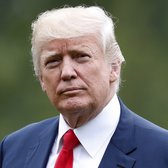The legal structure of the World Trade Organization has prevented President Donald Trump from fulfilling his promise to kick China out of the trade body, but his administration has taken aim at the organization in other ways.
On the campaign trail in 2016, Trump pledged to reverse "China's entry into the World Trade Organization," which he called one of the "worst legacies of the Clinton years."
Under a 2000 agreement backed by President Bill Clinton, China joined the WTO in December 2001 and remains part of the organization, which sets and implements trade rules for its 164 member countries.
But the Trump administration can't send China packing on its own. Never in the history of the WTO, or in the history of the General Agreement on Tariffs and Trade before it, has a country been thrown out of the organization, said Raj Bhala, distinguished professor at the University of Kansas School of Law and a senior adviser at Dentons, a global law firm.
There's nothing in the 1995 agreement establishing the WTO that authorizes one member country to expel another, nor is there anything in the accession contract that China signed in 2001 that allows China's removal, Bhala said.
"He has not fulfilled the promise, and it's not a promise he should've made, because there isn't a rule that would have allowed him to fulfill it," he said.
With China's removal off the table, the Trump administration has instead chipped away at the WTO itself by crippling the appellate body that handles trade disputes between member countries, and also by threatening to pull the U.S. out of the trade body entirely.
"Trump has made zero progress in kicking China out of the WTO, but he has edged closer to taking the U.S. out of that body," said Gary Hufbauer, a nonresident senior fellow at the Peterson Institute for International Economics.
Trump's work-around response
In normal times, an appellate body consisting of seven judges handles any appeals of decisions by dispute-resolution panels that handle trade disputes between member countries. Judges can serve up to two four-year terms, and three are needed to hear and decide cases.
The appellate body is like the "Supreme Court of world trade," Bhala said.
But as we noted when we last updated this promise, the U.S. under the Trump administration has been blocking the reappointment of judges. Two of the remaining three judges saw their terms expire in December 2019. As of June 23, only one remains.
"Trump has effectively shut down the appellate body by refusing to approve new members when the terms of old members expire," Hufbauer said. "Dispute panels are still convened, but without an appellate body, the losing party can choose to block an adverse decision."
Testifying before Congress on June 17, Robert Lighthizer, the U.S. trade representative, said that if the appellate body "never goes back into effect, I think that would be fine."
A number of member countries have since signed on to a temporary mechanism for resolving their disputes. The Multi-Party Interim Appeal Arbitration Arrangement, or MPIA, now covers 46 countries, including the European Union and China, Bhala said. Any member can sign on.
WTO countries that have subscribed to the MPIA can now have their appeals decided by three out of a pool of 10 arbitrators, Bhala said. But those arbitrators cannot rule on appeals involving disputes against the U.S., because the U.S. has not signed on to the MPIA, he said.
The Trump administration has also threatened to withdraw the U.S. from the WTO, a move that experts told us would require a massive legislative overhaul that would be possible only with widespread support among leaders in Congress and the U.S. business community. Sen. Josh Hawley of Missouri, an ally of Trump, introduced a resolution to that end in May.
But that wouldn't do anything about China's standing in the organization.
"That would almost be understating the metaphor of cutting off one's nose to spite one's face," Bhala said. "It would be like leaving a club where you like all the other members."
Other options for removing China?
There are other ways the U.S. could try to boot China from the WTO, but they would require "indirect" actions that are unlikely to succeed, Bhala said.
One method would involve the WTO's 164 member countries, which usually act by consensus, to pass a resolution ousting China. But getting countries on board would be tough. "Even if 163 members of the WTO agreed to that … China would still say no," Bhala said.
Another option, described in an August 2018 piece in the Wall Street Journal, focuses on an article in the General Agreement on Tariffs and Trade, the precursor to the WTO.
The article allows cases to be filed if a country believes the benefits it expects to get from the WTO are "being nullified or impaired" by the behavior of another country, even if that behavior doesn't specifically violate the agreement that established the WTO.
The U.S. could try to force China to voluntarily withdraw by lodging this kind of complaint over its economic system, Bhala said. "But that is really, really unlikely," he said.
Overall, kicking China out of the WTO is a near impossibility, but Trump has worked to stymie the organization in other ways. We rate this Promise Broken.


